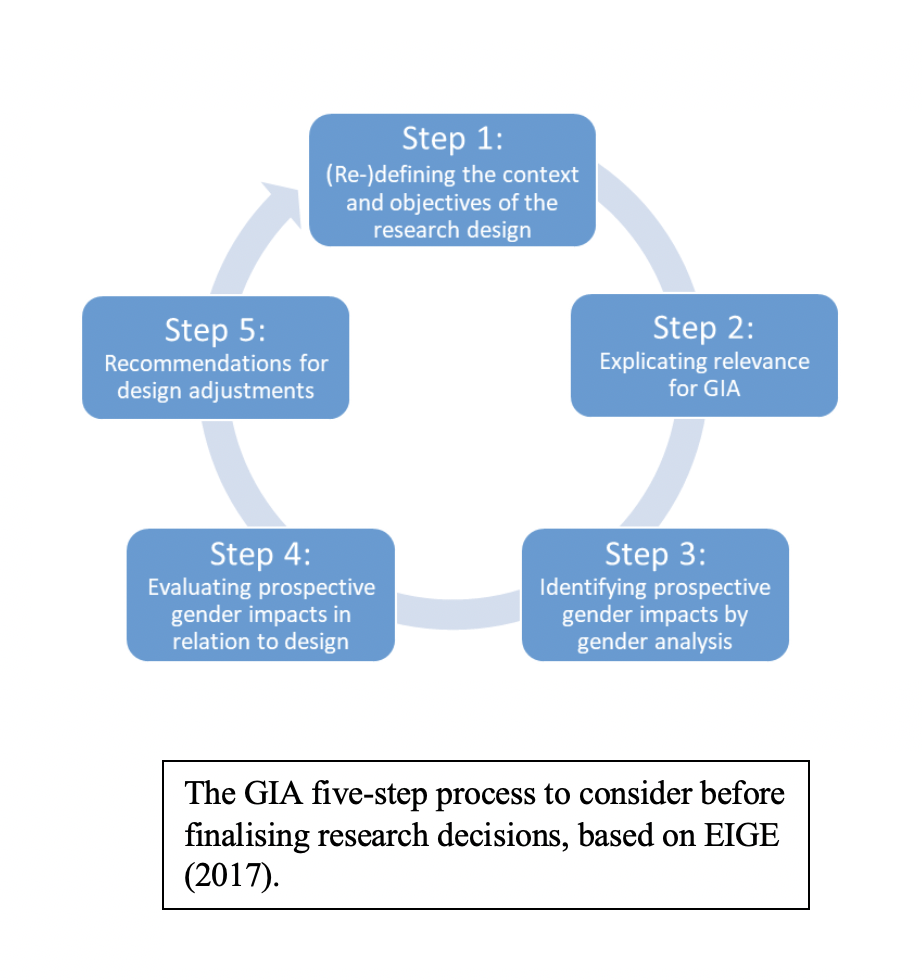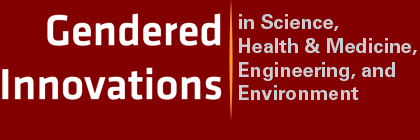 Gender Impact Assessment (GIA) is a stepwise process (see diagram) designed to evaluate the potential impacts of research before research decisions are finalized. The goal is for experts to provide evidence-based recommendations for research redesign—in the development phase. By employing the methods of gender and intersectional analysis, experts can assess: 1) the research objectives and priorities set (the people, contexts and knowledge that may have been overlooked in research design), 2) the conceptual research frameworks and analytical methods which may subconsciously exclude gender considerations, and 3) the research questions that were formulated with a specific focus that may exclude particular populations.
Gender Impact Assessment (GIA) is a stepwise process (see diagram) designed to evaluate the potential impacts of research before research decisions are finalized. The goal is for experts to provide evidence-based recommendations for research redesign—in the development phase. By employing the methods of gender and intersectional analysis, experts can assess: 1) the research objectives and priorities set (the people, contexts and knowledge that may have been overlooked in research design), 2) the conceptual research frameworks and analytical methods which may subconsciously exclude gender considerations, and 3) the research questions that were formulated with a specific focus that may exclude particular populations.
GIA is a technique increasingly used in line with the principles of Responsible Research Innovation (RRI) and in support of the United Nations Sustainable Development Goals (SDGs). It is particularly relevant to fields of research and development (R&D) that rely on technological and networked infrastructure, and depend on adaption, such as in transport, urban planning, energy, mining, hydropower and agriculture (e.g. Pelez & Hanna, 2019; Spitzner & Buchmüller, 2016; Hill et al., 2017a, 2017b; Graef et al., 2018). The five steps for GIA, based on Spitzner & Buchmüller (2016) and EIGE (2017), including the critical reflections of Bacchi (2010) and Verloo (2001, 2005):
| Step 1: (Re-)defining the context and objectives of R&D design |
|
| Step 2: Explicating the relevance for GIA |
Identify the gender dynamics at stake—either those already included or those that should be included. Consider:
|
| Step 3: Identifying prospective gender impacts by gender analysis |
What is the current state-of-affairs?
|
Symbolic order—hierarchical gender constructions and positioning:
|
| Step 4: Evaluating prospective gender impacts in relation to design |
Overall gender impacts seek to evaluate:
|
| Step 5: Recommendations for design adjustments |
Experts should provide data-driven recommendations:
|
Works Cited
Bacchi, C. (2010). Gender/ing impact assessment: Can it be made to work?, in: Bacchi, C., & Eveline, J. (eds.) Mainstreaming politics: Gendering practices and feminist theory, University of Adelaide Press, 17-37.
EIGE (2017). Gender Impact Assessment: Gender Mainstreaming Toolkit. Luxembourg: Publications Office of the European Union. https://eige.europa.eu/publications/gender-impact-assessment-gender-mainstreaming-toolkit Graef, F., Hernandez, L. E. A., König, H. J., Uckert, G., & Mnimbo, M. T. (2018). Systemising gender integration with rural stakeholders' sustainability impact assessments: A case study with three low-input upgrading strategies. Environmental Impact Assessment Review, 68, 81-89. Hill, C., Madden, C., and Collins, N. (2017a). A Guide to Gender Impact Assessment for the Extractive Industries. OXFAM Australia https://oxfamilibrary.openrepository.com/bitstream/handle/10546/620782/gt-gender-impact-assessement-extractives-010117-en.pdf?sequence=1 Hill, C., Thuy, P. T. N., Storey, J., and Vongphosy, S. (2017b). Lessons learnt from gender impact assessments of hydropower projects in Laos and Vietnam. Gender & Development, 25(3), 455-470. Peletz., N. and Hanna, K. (2019). Gender Analysis and Impact Assessment: Canadian and International Experiences. Canadian International Resources and Development Institute (CIRDI), Vancouver. Sauer, A.T. (2018) Equality Governance via Policy Analysis? The Implementation of Gender Impact Assessment in the European Union and Gender based Analysis in Canada, Bielefeld: transcript Verlag. Spitzner, Meike; Buchmüller, Sandra (2016). Energiesuffizienz - Transformation von Energiebedarf, Versorgungsökonomie, Geschlechterverhältnissen und Suffizienz. Wuppertal Report 8. ISSN 1862-1953. https://energiesuffizienz.files.wordpress.com/2014/06/wr8.pdf. Verloo, M. M. T. (2005). Mainstreaming gender equality in Europe: A critical frame analysis approach. Επιθεώρηση Κοινωνικών Ερευνών, 117, 11-34. https://repository.ubn.ru.nl/bitstream/handle/2066/165981/165981.pdf




